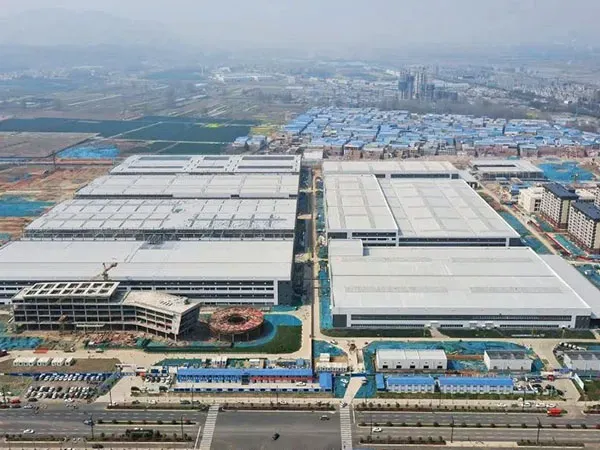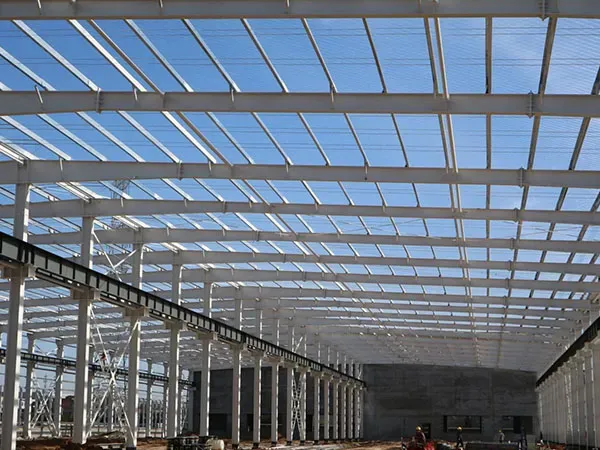Time:2025-02-25 01:46:44 Source:Sanjian Meichen Steel Structure
In the rapidly evolving global construction industry, choosing the right structural material is crucial to project success. Among numerous options, steel structures, with their superior performance and wide applicability, have become the preferred choice for everything from high-rise skyscrapers to large industrial plants. More than just a material, it is a powerful driver of innovation, efficiency, and sustainability in modern architectural design. This article will delve into the core advantages of steel structures in architecture and explore their potential to shape future urban landscapes.
Compared to traditional concrete buildings, steel structures replace reinforced concrete with steel plates or profiles, which has obvious advantages in the field of construction.
Steel structures are highly favored due to their unparalleled performance characteristics:
Excellent Strength and Lightweight Design:
High Strength: Steel's tensile strength and yield strength are significantly higher than those of concrete and wood. This means that, for the same load, steel structures require smaller cross-sectional dimensions and lighter components.
Lightweight: Compared to traditional concrete structures, steel structures are lighter. This not only reduces foundation loads and costs, but also provides architects with greater design freedom, enabling the realization of large spans and expansive spaces. For example, in buildings requiring expansive spaces, such as stadiums or exhibition centers, steel structures can easily achieve column-free, long spans.
Excellent Seismic and Wind Resistance:
Toughness and Ductility: Steel possesses excellent toughness and ductility. During earthquakes or strong winds, it absorbs and dissipates energy through its deformation, avoiding sudden brittle failure and significantly improving building safety. Overall Stability: Steel structures typically utilize welding or high-strength bolt connections to form a stable framework that effectively resists horizontal shear forces and ensures building stability during extreme weather and natural disasters.
Efficient Construction Speed and Cost-Effectiveness:
Factory Prefabrication, On-Site Assembly: Most steel components can be standardized and manufactured in the factory, ensuring precise dimensions and controlled quality. On-site installation requires only simple hoisting and connection, significantly shortening the construction period and reducing the complexity of on-site work.
All-Weather Construction: Steel structure installation is less affected by weather conditions and can be carried out even in winter, contributing to on-time project delivery.
Reduced Overall Cost: While steel may have a slightly higher initial cost, its advantages, such as rapid construction, reduced labor, reduced foundation costs, and ease of maintenance, can provide significant long-term economic benefits.
High Sustainability and Environmental Value:
100% Recyclable: Steel is one of the most recycled materials in the world. Its waste can be recycled endlessly without loss of performance, significantly reducing the consumption of natural resources and environmental pollution.
Reduced On-Site Waste: Factory prefabrication reduces the generation of on-site garbage and construction waste. Energy Saving and Emission Reduction: After demolition, steel-structured buildings can be reused, reducing material consumption and energy input for new construction and aligning with global trends in green building and sustainable development.
Excellent Design Flexibility and Aesthetic Expression:
Free Formability: Steel can be easily fabricated into a variety of shapes and sizes, providing architects with tremendous design freedom, enabling the realization of complex and creative architectural forms, such as streamlined and irregular shapes.
Transparency and Light: The slender nature of steel structural components allows for the use of more glass curtain walls on building facades, allowing in ample natural light and creating airy and spacious interior spaces.
Industrial Aesthetics: Exposed steel structures inherently possess a unique industrial aesthetic, widely used in modern design to showcase a fusion of strength and technology.

Steel structures have an extremely wide range of applications, encompassing nearly all types of buildings:
High-rise and super-high-rise buildings: The high strength and light weight of steel structures are crucial for achieving a city skyline.
Large public buildings: These buildings, such as stadiums, convention centers, airport terminals, and theaters, require large spans and open spaces, making steel structures an ideal choice.
Industrial plants and warehouses: Their rapid construction, large spaces, and flexibility in adapting to equipment layout make them a top choice for industrial buildings.
Bridges: Steel bridges, with their elegant shapes and strong load-bearing capacity, occupy a prominent position among all types of bridges.
Residential buildings: With technological advancements, steel-framed residential buildings are becoming increasingly popular, especially in areas with high seismic protection requirements.
Temporary and modular buildings: The prefabricated nature of steel structures makes them excellent for rapid deployment and mobile construction.
Despite the significant advantages of steel structures, they also present challenges, such as fire protection, corrosion resistance, and relatively high initial costs. However, with continuous technological advancements, these challenges are gradually being overcome:
Fire-retardant coatings and technologies: New high-performance fire-retardant coatings and panels can effectively improve the fire resistance of steel structures.
Corrosion protection: Technologies such as hot-dip galvanizing and anti-corrosion coatings, combined with regular maintenance, can ensure the long-term durability of steel structures in harsh environments.
BIM technology and intelligent construction: The widespread application of Building Information Modeling (BIM) can optimize the entire process of steel structure design, production, and construction, further improving efficiency and reducing costs.
New high-strength steel: The development of higher-performance steel will make future steel structures lighter, stronger, and more sustainable.
Prefabricated building trends: The deep integration of steel structures and prefabricated building models will drive the construction industry's transformation towards industrialization and intelligentization.

Q1: What is the fire resistance of steel structures?
Steel loses some strength at high temperatures, but by applying fire-retardant coatings and adding protective layers, the fire resistance of steel structures can be effectively improved to meet building fire code requirements.
Q2: Is the maintenance cost of steel structures high?
Maintenance of steel structures primarily focuses on corrosion and fire prevention. Regular inspections and maintenance can extend their service life. Compared to concrete structures, steel structures are relatively economical to maintain.
Q3: What types of buildings are steel structures suitable for?
Steel structures are widely used in a variety of building types, including high-rise buildings, bridges, stadiums, industrial plants, warehouses, and more. They are particularly well-suited for projects with high structural performance requirements.
Steel structures, with their exceptional strength, toughness, environmental friendliness, construction efficiency, and design flexibility, are undoubtedly one of the most promising materials in modern construction. They not only meet society's current demands for safe, efficient, and environmentally friendly buildings, but also, with their limitless innovative potential, are leading the construction industry towards a more sustainable and intelligent future.
Choose Meichen Steel Structure and build a better future together!
If you are considering steel structures for your next project and would like professional design, production, and construction services, please feel free to contact us. With our extensive experience and advanced technology, we are committed to providing you with high-quality steel structure solutions.